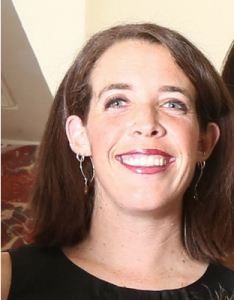Making Math Real in the IB
Hannah Starbuck
In 2019, the International Baccalaureate rewrote their math curriculum, transitioning from three different levels of classes to two. The “newest” class of the two is called Applications and Interpretations, where students consistently look at how math is applied in a real world setting. They are frequently asked to interpret the significance of the different values they calculate and what those values mean in the context of the problem they are solving. While I like the idea of having students explore mathematics through an application based lens, I find that some of the applications are far-fetched and may have little real connection to students.
Now in my third year of teaching IB mathematics, I am familiar with the Applications and Interpretations curriculum, both Standard and Higher Levels. I saw an opportunity to make the Standard Level classes more engaging and interesting for students through projects.
This school year, I’ve been creating projects that explore the different careers that utilize mathematics. I’ve combed through the Applications and Interpretations textbook and have racked my brain for possible careers that meaningfully apply the math content of the course syllabus. My idea is to ensure each chapter has its own project, or that there be content spread across multiple chapters that can be consolidated into one large project. Here I have to give credit to a former colleague of mine, Rob Barnett, who was kind enough to share his Demographer Project template a few years ago. His work inspired me to start thinking about different careers that use math and that could also be fun and interesting for students to think about.
Each project asks for the students to adopt the mindset of a certain career or job. In addition to my own version of the Demographer Project, I have created projects which ask students to think like an artist, a game maker and an architect.
As demographers, students were asked to investigate a population they were genuinely interested in and wanted to learn more about. Students had to find reliable and valid data on their population, graph their data and find a suitable model for their data. They looked at whether exponential models or linear models were a better fit and explored a concept called the coefficient of determination, which is an indicator on how well data fits a particular model. Students were also asked to make future predictions about their population, in relation to their models, and discuss the implications of their results. I asked students to take an objective and unbiased approach to interpreting their results and asked them to discuss the implications of their results, as well as how realistic they were.
The feedback on this project was very positive. Students were asked to write a reflection about the project and discussed things they liked and things they would change. The majority of my students loved the fact that they got to choose their own population and got to study trends over time, which included past history, the present situation and some speculation for the future. They all said in unison that they became more informed about their particular population. So for me, the interdisciplinary approach was a win, even without the time to collaborate directly with colleagues in other disciplines.
The biggest critiques of the project were the difficulties using technology and doing the project mostly remotely. Students had some difficulties understanding the different functions on Desmos and Google
Sheets. Though they initially lacked inexperience with these platforms and required a lot of support, after a while, they got the hang of it and understood the significance of each operation.
Another project I created based on similar themes asked the students to think like an artist. Students created an artistic piece using Pythagorean Spirals. This allowed students to access their creativity, demonstrate their understanding of the Pythagorean Theorem and create their own original work. This project was generally well-received and students enjoyed watching their art come to life as well as observing the nice patterns that occur within the Pythagorean Spirals.
I’ve also recently finished a project that focuses on Probability where students are asked to think like a game maker at a carnival and need to explore the concept of fairness. Students look very analytically at theoretical and experimental probability, different ways of representing/visualizing probability and binomial probability. The culminating activity is a carnival where students have the opportunity to play each other’s games.
I’ve also completed a project that focuses on right triangle and non-right triangle trigonometry where students are asked to think like an architect. Their project is to build a school with a small group of people and they have certain conditions they need to respect. This project allows students to explore the applications of the sine and cosine rule, fundamentals of trigonometry and some 3D geometry. Though these concepts have such interesting and abstract proofs, they provide an even richer application for students to construct something that has been a part of their daily lives.
While the projects are fairly content heavy, I have done my best to establish the importance of collaboration, studying concepts with practical and realistic application and allowing students to create something that is their own vision. There are also certain skills that I think are valuable for students to take away. These include being able to efficiently use technology, using different math “tools” such as rulers, protractors, and calculators and interpreting the meaning of values and how they relate to the larger problem they are solving.
I am continuing to work on projects that focus on being a data analyst, reporter, modeler, urban planner, and more. I find the curriculum planning to be very rewarding and then even more satisfying as I watch my students come alive while engaged in something they’re truly excited about. I am always happy to share materials, you be interested.
As each school year passes, it becomes more and more apparent to me that teaching mathematics with some sort of meaningful and interesting application is crucial to student learning and engagement. Packer (2022), a writer for The Atlantic, asks, “What is school for?” A former teacher responded, “The original thinkers of public education were concerned almost to a point of paranoia about creating self-governing citizens.” The word self-governing is powerful, especially in the context of education. Self-governing is defined as “having control or rule over oneself”. By allowing students to have choice over what they learn in their different classes, we are empowering them to have control over their learning and hopefully communicating the message of self-governing. Karakoc and Cengiz (2015) discuss a couple approaches of realistic mathematics education that include “developing instruction based in experimentally real contexts” and “designing activities to promote pedagogical strategies that support students’ collective
investigation of reality”. These ideas confirm the importance of application-based mathematics to scenarios that students care about and show a genuine interest in. Howe (2018) writes “students benefit from learning experiences that are meaningful, relevant and well-connected to their own experiences. For that to happen, the people teaching those students must be prepared to take on new attitudes of reflectiveness and inquisitiveness”. This is a great opportunity for those of us in education, specifically math education, to create projects and high ceiling math problems that directly relate to students. It also gives them a chance to research topics and ideas that they are truly passionate and interested in and allows them to find authentic and genuine connections to mathematics.
If you would like to discuss project ideas or have questions/comments, please feel free to email me at hstarbuck@fcaq.k12.ec.
ABOUT THE AUTHOR
Hannah Starbuck earned her Undergraduate Degree in Mathematics from Fort Lewis College and her Master’s Degree in Math Education from University of Colorado – Denver. She has taught math in Colorado, Switzerland and Ecuador. She currently lives and teaches in Quito, Ecuador and is writing projects that align with both IB DP and MYP curriculum.
BIBLIOGRAPHY
Chang Wathall, Jennifer, et. al. Mathematics: Applications and Interpretation Standard Level. Oxford University Press, 2019.
Packer, G. (2022, March 10) The Grown-Ups Are Losing It. The Atlantic. https://www.theatlantic.com/magazine/archive/2022/04/pandemic-politics-public-schools/622824/
Karakoc, G & Alacaci, C. (2015). Real World Connections in High School Mathematics Curriculum and Teaching. Turkish Journal of Mathematics and Computer Education. https://www.researchgate.net/publication/276172693_Real_World_Connections_in_High_School_Mathe matics_Curriculum_and_Teaching
Howe, E.R. (2018, September 11) Let’s Teach Students Why Math Matters in the Real World. The Conversation.
https://theconversation.com/lets-teach-students-why-math-matters-in-the-real-world-102316






